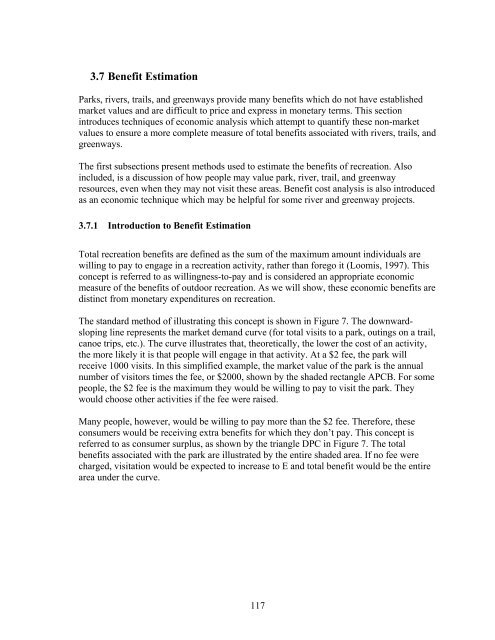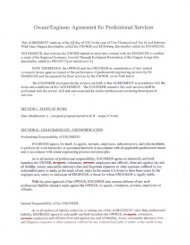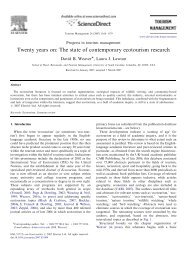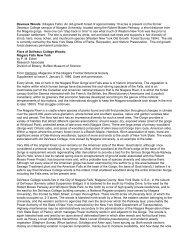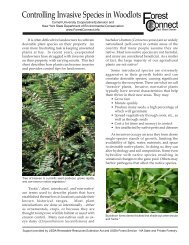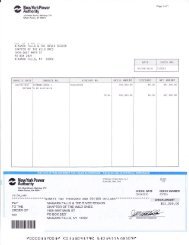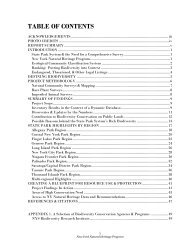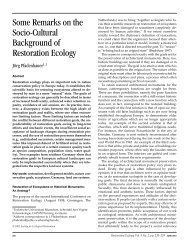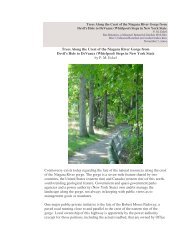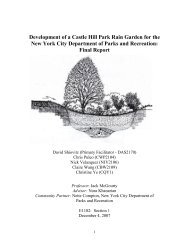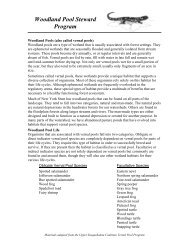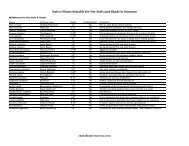Economic Impacts of Parks, Rivers, Trails and Greenways
Economic Impacts of Parks, Rivers, Trails and Greenways
Economic Impacts of Parks, Rivers, Trails and Greenways
Create successful ePaper yourself
Turn your PDF publications into a flip-book with our unique Google optimized e-Paper software.
3.7 Benefit Estimation<strong>Parks</strong>, rivers, trails, <strong>and</strong> greenways provide many benefits which do not have establishedmarket values <strong>and</strong> are difficult to price <strong>and</strong> express in monetary terms. This sectionintroduces techniques <strong>of</strong> economic analysis which attempt to quantify these non-marketvalues to ensure a more complete measure <strong>of</strong> total benefits associated with rivers, trails, <strong>and</strong>greenways.The first subsections present methods used to estimate the benefits <strong>of</strong> recreation. Alsoincluded, is a discussion <strong>of</strong> how people may value park, river, trail, <strong>and</strong> greenwayresources, even when they may not visit these areas. Benefit cost analysis is also introducedas an economic technique which may be helpful for some river <strong>and</strong> greenway projects.3.7.1 Introduction to Benefit EstimationTotal recreation benefits are defined as the sum <strong>of</strong> the maximum amount individuals arewilling to pay to engage in a recreation activity, rather than forego it (Loomis, 1997). Thisconcept is referred to as willingness-to-pay <strong>and</strong> is considered an appropriate economicmeasure <strong>of</strong> the benefits <strong>of</strong> outdoor recreation. As we will show, these economic benefits aredistinct from monetary expenditures on recreation.The st<strong>and</strong>ard method <strong>of</strong> illustrating this concept is shown in Figure 7. The downwardslopingline represents the market dem<strong>and</strong> curve (for total visits to a park, outings on a trail,canoe trips, etc.). The curve illustrates that, theoretically, the lower the cost <strong>of</strong> an activity,the more likely it is that people will engage in that activity. At a $2 fee, the park willreceive 1000 visits. In this simplified example, the market value <strong>of</strong> the park is the annualnumber <strong>of</strong> visitors times the fee, or $2000, shown by the shaded rectangle APCB. For somepeople, the $2 fee is the maximum they would be willing to pay to visit the park. Theywould choose other activities if the fee were raised.Many people, however, would be willing to pay more than the $2 fee. Therefore, theseconsumers would be receiving extra benefits for which they don’t pay. This concept isreferred to as consumer surplus, as shown by the triangle DPC in Figure 7. The totalbenefits associated with the park are illustrated by the entire shaded area. If no fee werecharged, visitation would be expected to increase to E <strong>and</strong> total benefit would be the entirearea under the curve.117


